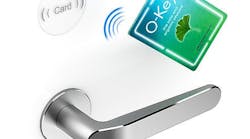"Are You Ready?” This early wireless message by Guglielmo Marconi in 1897 signaled the beginning of a wireless era which continues to change and grow. During that same time period, mechanical key systems evolved from skeleton type keys to the type of pin tumbler keys we use today. Until a few decades ago, very little thought was given to how wireless technology may be used to replace the mechanical key as the credential of choice. The first electronic locking systems required some physical interaction such as pressing a keypad or swiping a magnetic stripe card.
Mobile phones first appeared In the 1970s. Early models were large, heavy, and cumbersome to use. During the past twenty years, cellphones have become smaller and now include many added features such as cameras, internet access, text messaging and wireless communication (Bluetooth, infrared, etc.). Cell phones with these added features came to be known as “smartphones.”
The emergence of "smart" cellphone features in a relatively inexpensive and small cell phone package has resulted in an explosion of sales. It is estimated that 50 percent of the U.S. population currently owns a smartphone and predictions are that by the end of 2013, approximately 70 percent of cellphone users will be using smartphones. The most interesting feature from a security industry standpoint is the ability to wirelessly commumicate with specially equipped locksets.
The days of having a key ring in your pocket filled with house, office and auto keys is gradually coming to an end as cell phones containing Near Field Communication (NFC) or Bluetooth technology supplant the venerable metal key. For example, at ISC West 2013, Ingersoll Rand (IR) will discuss NFC and HID Global will update the industry on the latest access control trends. Phone usage as a credential has been announced as part of the HID presentation. A presentation last year by Assa Abloy at ISC outlined many future developments in wireless NFC communication. Now those developments are ready and available.
While Ingersoll Rand, ASSA ABLOY and others are aiming for wireless cellphone usage in commercial building applications, residential applications have not been overlooked. Some of the currently available lock products which allow smartphone operation in residences include:
- Kwikset SmartCode Lever with Home Connect Technology. This is a keyless entry lockset. Homeowners can monitor and control their door lock using a choice of web enabled, home automation or security systems. ADT has just announced a security monitoring program which can control a Kwikset eletronic lockset.
- Schlage Touchscreen Deadbolts. This ANSI grade 1 deadbolt features Nexia Home Intelligence. The unit can contain up to 30 unique access codes. Codes can be set to time zones or for temporary use as needed. A built-in alarm warns owners if the lock is tampered with. Nexia Home Intelligence enables homeowners with a cellphone to lock or unlock the Schlage Touchscreen deadbolt from anywhere in the world.
- Yale Real Living Touchscreen Deadbolt locks have an illuminated touchscreen display and also provide spoken instructions in three languages - English, Spanish or French. The Yale Touchscreen Deadbolt is Z-Wave enabled and can also use a HomeSteer system for operating lock controls via smartphones and tablets. Up to 250 separate user codes can be entered. A tamper switch is included and a privacy feature can be set to lock out all users when required.
- RemoteLock contains both a keypad and includes remote operation by smartphone. RemoteLock products are available as either a deadbolt or handleset form. Text alerts are available by phone whenever the lock has been operated. Temporary codes can be entered to allow guests to operate the lock for a short time period. A power management feature can be set so the lock only connects to the Internet at wide intervals to conserve battery power. A low monthly fee is required for cellphone operation.
- Lockitron advertises an auxiliary unit which is designed to fit over the turn knob of an existing deadbolt. A bracket holds the unit in place. Lockitron units can connect to the internet with built-in Wi-Fi. The Lockitron unit can then be controlled by a smartphone from anywhere in the world. On some smartphones it is possible to have the Lockitron sense the existence of a specific Bluetooth 4.0 signal and automatically unlock the Lockitron unit hands-free.






